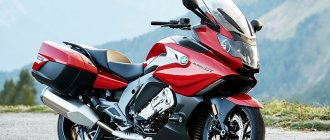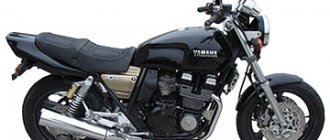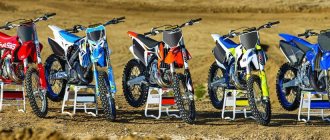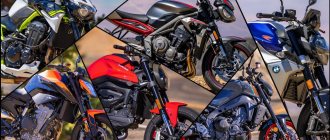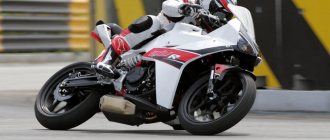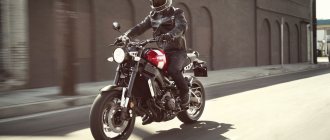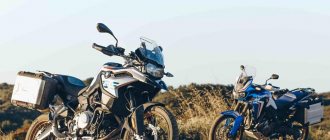BMW K1200GT
Model class : sport-tourist
Years of production/sales : 2002-2008
BMW K1200GT model was first introduced in 2002 and is built on the basis of the frame, engine and chassis of the BMW K1200RS, differing from the latter in more developed wind protection, an electrically adjustable windshield, a wider saddle and more comfortable ergonomics of the handlebars and footpegs.
Main generations of BMW K1200GT:
- BMW K1200GT K41 (2002-2005) – first generation. Models of these years are built on the basis of the BMW K1200RS and differ in plastic design. Engine: longitudinal 4-cylinder block 1171 cc. at 130 hp
- BMW K1200GT K44 (2006-2008) – second generation. The model gets a new look, a new 1157 cc vertical engine. see at 152 hp from K1200S and K1200R, Duolever instead of Telelever and semi-integral ABS III without electric boost. Electronic suspension adjustment is available as an option.
Otherwise, the BMW K1200GT model has the classic features of BMW K-series motorcycles: an in-line 4-cylinder liquid-cooled engine, proprietary Telelever and Paralever suspensions, ABS and a cardan drive. Touring options include an adjustable steering wheel and saddle, heated grips, electrically adjustable windshield height, standard saddlebag mounts, cruise control, etc.
The BMW K1200GT model was produced until the end of 2008, after which it was replaced by an updated version - the BMW K1300GT.
K1200GT
Due to the lack of content in this thread, I’ll add a couple of lines about my BeMeV.
This is a 2007 K1200GT. A bright representative of a wonderful family that originates from the legendary “brick”.
This is an unscrupulous extortionist, a provocateur and a rare boor! And he oh... ..new!
The only decent thing he has is a suit. It looks so solid, with an abundance of plastic it even looks like a scooter.
Although it still bears echoes of warmer times, it seems to me that this is where marketers have already begun to prepare the public for the fact that a motorcycle with a mileage of 30 thousand kilometers will be expensive to maintain. sooo expensive. Very recent examples that outraged my frugality: a clutch clutch package from 45 tr. Clutch slave cylinder from 36 liters. The last one was changed because of the cuff, a small rubber ring, it only comes together with the left remote control. The Internet scares me with a weak gearbox and cardan transmission, I don’t even want to look at the prices for these items and it’s so sad.
How many times, when leaving home, did I tell myself: I’m driving calmly, smoothly and proudly, carrying myself above the road and arrogantly and coldly looking at the stream. This is a solid Bavarian motorcycle. I am a respectable adult. But this same comrade, he doesn’t know how to drive smoothly!!! It only has smooth suspension settings in comfort mode. The engine jerks below two thousand, it needs to be added, well, once again added, the suspension is tightened, it leans in a turn, it feels faster... and now you’re already kicking some mustacheless sportsman’s ass, hitting him on the highway under 200 or beyond, knocking him out of turn after turn and doing other unpleasant things.
He steers in a very unique way. At low speeds, it’s better not to move the steering wheel; it will turn exactly as much as you tilt it. Rolling it in place is another strength exercise. I don’t even want to remember about picking him up when he fell (and without even thinking about the upcoming painting of the plastic after the fall). The center of gravity, although quite low due to the forward-leaning engine and the traditional lack of a frame, is still far from the Goose in this regard. But I still don’t understand where his 320 and my 90 kilograms are spread if he drives. He will not forgive a single mistake, and if you do everything academically correctly, he allows you to follow mopeds in Moscow traffic jams, with panniers, and push them in the back.
It has 160 horsepower, it has some immodest amount of torque, it has a maximum speed of 260 and that’s due to the limiter, but my own limiter still works earlier.
It has a consumption of 6.5 liters/100 km in “war” mode and 4.5 liters in “Finland has the largest fines in the world” mode.
It has heating for everything and everything, an adjustable windshield, an adjustable seat, an adjustable suspension, for loading and preloading, and from a button on the steering wheel, and right on the go. He has a bunch of other useful and very pleasant things, but you don’t use it all at all, because you simply don’t have time for it and generally forget about it on the go.
But to note such a wonderful thing as intelligent abs, combined brakes (when you press the front lever, the rear one is activated) and the force is distributed according to needs, the traction control system in the same complex is extremely useful.
Well, we need to say something about wind protection: the aerodynamics are excellent. With the windshield fully raised, you can drive, although not wearing a cap with the GoldWing logo, but with the visor open for sure, up to 140 km/h, then the visor closes itself. In the rain, only a small part of your shoulders get wet, the main thing is not to slow down below one hundred. Even the legs remain dry, although the left one has to be slightly tucked with the toe towards the engine. But if it’s dry and warm, the most appropriate position for the windshield is below and the body above the tank. Then the air flow tightly clasps the shoulders, holds the head, while the turbulence is distributed so that the neck is not pulled back, and... this is a unique feeling, it’s like flying or dancing.
Yeah... This is the best motorcycle, and there is absolutely no alternative to it. I tested both a dumbbell and a GT 1600 (by the way, I found very few differences between them), this is absolutely not the same. They are soft, absolutely measured, non-aggressive and very environmentally friendly. at the same time they weigh a good 40 kg more. It’s true that the F800GT still exists, but here I have a classic attitude - I haven’t driven it, but I condemn it! The K1300S, of course, remained in service for a long time and is a wonderful motorcycle, but its wind protection and landing position are somewhat more radical, as a result of which the touring potential is significantly lower. RT-ha, of course, she’s also good, but comparing her with mine... well, it’s like an excellent student in combat and politics with a chess class. I’m silent about the geese, because even though I’m driving my own into chips, I’m sorry.
True, there are rumors that somewhere in the world there are motorcycles from other manufacturers, but it seems to me that they are lying.
And also mine, the last of the family with separate turn signal switches, but for this alone you can forgive everything...
Well, a few photos:
Specifications
Technical characteristics of BMW K1200GT:
| Model | BMW K1200GT |
| Motorcycle type | sports tourist |
| Year of issue | 2002-2008 |
| Frame | aluminum |
| engine's type | 4-cylinder in-line, longitudinal (from 2006 - transverse) arrangement |
| Working volume | 1172 cc (since 2006 - 1157 cc.) |
| Bore x Stroke | 70.5x75 mm (since 2006 79x59 mm) |
| Compression ratio | 11.5:1 (since 2006 - 13.0:1) |
| Cooling | liquid |
| Number of valves | DOHC, 4 valves per cylinder |
| Fuel supply system | Bosch Motronic MA 2.4 injector (from 2006 - BMW-K) |
| Ignition type | electronic |
| Maximum power | 130 hp at 8750 rpm (since 2006 - 152 hp at 9500 rpm) |
| Maximum torque | 117 Nm at 6750 rpm (since 2006 - 130 Nm at 7750 rpm) |
| Transmission | 6-speed |
| type of drive | cardan |
| Front tire size | 120/70 ZR17 |
| Rear tire size | 180/55 ZR17 |
| Front brakes | 2 discs, 320 mm, 4-piston calipers (ABS) |
| Rear brakes | 1 disc, 285 mm, 4-piston caliper (ABS) (from 2006 - 294 mm, 2-piston caliper) |
| Front suspension | BMW Telelever, stroke - 115 mm (since 2006 - Duolever) |
| Rear suspension | pendulum BMW Paralever (preload and rebound adjustment), stroke - 150 mm (since 2006 - 135 mm) |
| Overall dimensions (LxWxH) | 2250 x 920 x 1340 mm (since 2006 - 2318x990x1438 mm) |
| Seat height | 820-840 mm (800-820 mm - with low seat) |
| Gas tank capacity | 20.5 l (since 2006 - 24 l) |
| Maximum speed | 230 km/h (since 2006 - 253 km/h) |
| Acceleration to 100 km/h (0-100) | 3.4 sec (since 2006 - 2.8 sec) |
| Motorcycle weight (curb) | 300 kg (since 2006 - 282 kg) |
Oh, this series "K"! How many wonderful cars came out of the BMW assembly line under this letter! Nothing like what is usually called the term "Bavarian motorcycle". Down with the traditional boxer, long live the multi-cube “row”! Yes, the main difference between motorcycles in this series is an in-line, longitudinally mounted engine with a horizontal arrangement of four cylinders.
The tourist version of the well-known sports tourer K1200RS was released at the end of 2002. The design of the powertrain and chassis has remained virtually unchanged, but there have been improvements, as well as attributes and options that can only be matched to a GT-level car. I would like to immediately note that for decades BMW constructors and designers have managed to maintain the characteristic style of motorcycles in this series. The appearance of the device, solid and swift at the same time, clearly indicates its purpose. Traveling with dignity and comfort, safely and quickly: these impressions are already created by visual acquaintance.
And what will he show in action? But in reality everything is the same as with people: power, comfort, I would even say, coziness! How else to define sensations...
A wide seat (heated and two height positions) allows you to cover kilometers without fatigue, excellent wind protection (electrically adjustable glass in height) blurs the feeling of speed, steering controls in a specific style from BMW are already familiar (the traveling cruiser BMW R1200CL has become almost family to me) , and even seem comfortable. And the two-position heated steering wheel grips only complement the overall feeling of caring for the pilot. All the prerequisites for calling the model a real traveler. Add to this the removable panniers, and the portrait is ready: a trucker, packed according to the latest travel fashion. What a sight for sore eyes!
All this is on the surface. Deep familiarity still reveals negative aspects. The first thing that bothered me was the feeling of a very high center of gravity. At first, subtle maneuvering was difficult. The desire of the three-hundred-kilogram apparatus to leave the state of equilibrium is too great. Even a small angle of inclination caused a panicky feeling of “elephantoma”, and attempts to roll this BMW by hand were reminiscent of a sumo wrestler. And this is after two months of training with the equally well-fed R1200CL!
The difficulty of applying force also arose due to poorly placed rear yokes. The grip when placing the motorcycle on the center stand is similar to a weightlifter's grip - wide and low. The feeling of “short legs” was also an unpleasant discovery. What is this? Even with the saddle in the lower position, my toes barely reach the ground. Very strange... It seemed to me that motorcycles are designed for the average person - my height is 182 cm. For the sake of experiment, I put the seat in the upper position and was not too lazy to move the footrests to the very top as well. Trying to perch on the resulting structure stirred up a sea of emotions in me, and not the most joyful ones. Imagine yourself riding an overturned boat in a stormy sea (or a “banana” in beach activities). Not comfortable, to put it mildly. Apparently, for German designers, the average height of a person is somewhere like Michael Jordan with a cap, no less.
Of course, you can get used to everything, and after a couple of thousand kilometers the specific weight distribution was no longer frustrating. Maybe it’s sadomasochism, but then I began to like to quickly and inevitably tumble into the gentle arcs of road junctions, change lanes in a sweeping manner, and lean solidly in S-shaped turns. A kind of superstructure over the highway. Of course, you won’t feel like an athlete, even with the prefix “ex,” but you certainly will be an advanced motorcycle tourist.
Ergonomics have already been discussed, but what about the engine and suspension? I confess, at first I was not impressed by either one. Understanding came over time, or rather, over kilometers. And the feeling of harmony comes even later. An old acquaintance - the in-line engine of the K series - has always been distinguished by restraint. Despite the solid power (130 hp), he did not show any unbridled feelings. The automotive theme is visible both in the design and in the characteristics. It is enough to cross the 2000 rpm mark, and you can enjoy the “trolleybus traction” until the end of the tachometer. However, this goes well with the rest of the motorcycle’s habits. The abbreviation GT is definitely appropriate: long-distance dynamic travel is the native element of this BMW.
What is also clear is that in the city crowd it is clearly clumsy, and only removing the side panniers allows you to feel at ease in the usual “cork” mess. The width of the luggage cases is clearly larger than the “bubble” of the front tail, so it is impossible to control the rear dimensions in the mirrors. Not surprisingly, this leads to regular cosmetic effects on overtaken cars. Naturally, not everyone likes this, including the BMW pilot.
Dexterity comes with time, and even “sleepy” suspensions do not prevent you from shifting among the “tin cans”, making turns almost at your knees and breaking away from annoying “street racers” in the traffic. The experience of country tracks only added confidence. Smooth, gentle turns can be made until sparkling with the bots, without losing any confidence in control. Structurally, it is not possible to tilt more than the tire can support. The pristine tread strip remains even after intentionally squeezing the pegs. The supply is large.
If you add to the portrait of this BMW the presence of ABS, a traditional cardan drive, a capacious gas tank and very moderate fuel consumption, it turns out that there is nothing more you could want for your trip. Gourmets may require more power, but these are whims. Believe me, a three-hundred-kilogram motorcycle confidently accelerates with this “livestock”, and, if desired, even jigitizes on the rear wheel. Verified. One problem is that the clutch disc is small in diameter and does not withstand such abuse for long.
The reliability and service life of the engine are legendary. It is not without reason that in many countries police units and other city services use the BMW K series. Things are a little worse with the checkpoint. At peak loads, it is not uncommon to engage a false neutral between fourth and fifth gears. A most unpleasant feeling, it must be noted. The solution was not found immediately. The gearbox, which was very gentle when switching in normal modes, refused to turn on clearly under a heavier load, and only a harsh impact on the lever reduced the likelihood of false activation to a minimum. At the same time, the charm of the measured “tourist” was lost, but the perky character of the “athlete” did not appear - the leg quickly got tired, and that’s all. Perhaps this is one of the few BMW motorcycles that did not present any surprises - everything was as expected. Dignity, prosperity, pleasure - all within reasonable limits. It seemed to me that of the entire BMW range, the K1200GT is closest to motorcycles in the traditional sense. I think you understand what I mean...
Of course, the K1200GT has found its place in the sun. The rejection of the design attributes of the sports car predecessor only benefited him. The new guise turned out to be more relevant: a large-sized touring motorcycle capable of racing at very high speeds on suitable roads. With the new driver's position, the vehicle has become more controllable and obedient, despite its large mass. I think the new GT is more harmonious than its predecessor. After all, there are few motorcycles in the world that you remember with warmth. And the BMW K1200GT is just one of these.
Motor review No. 4, 2004: Alexey Karklinsky
